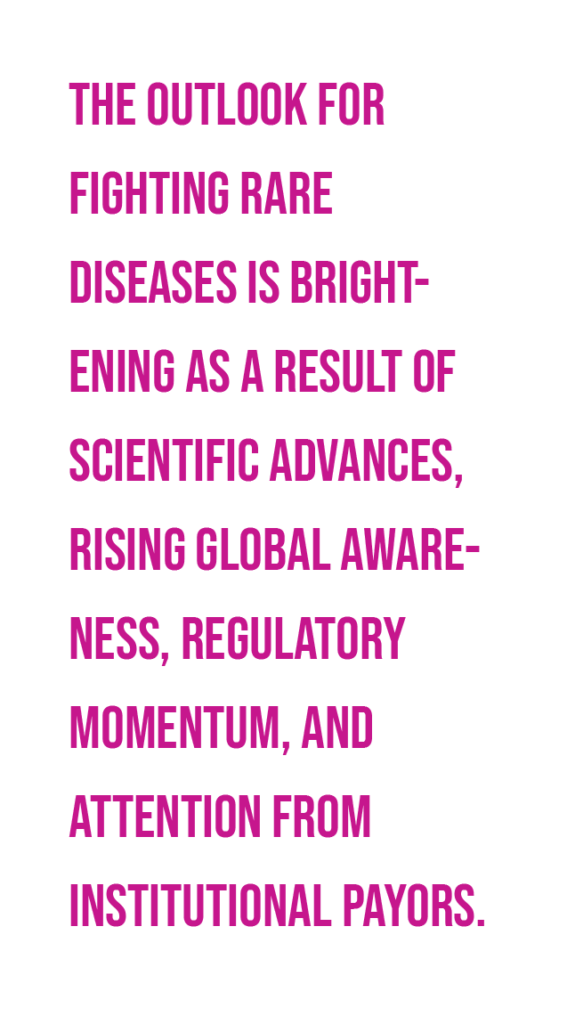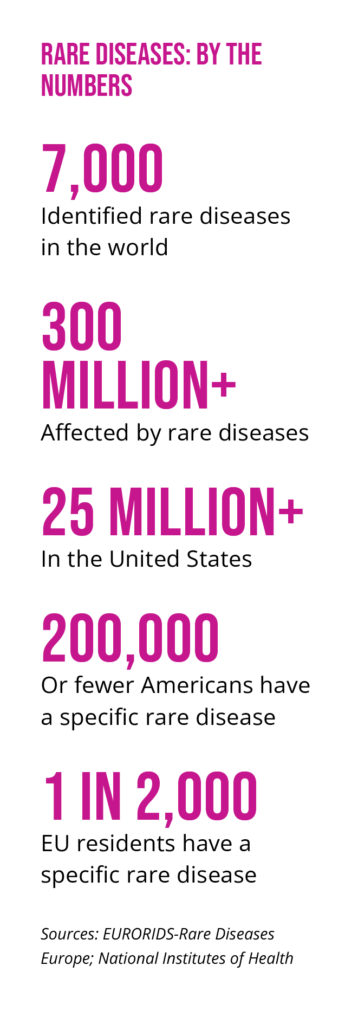Global Health

Rare diseases are considered rare because they affect relatively tiny numbers of people: up to 200,000 in the U.S., for example, and less than one in 2,000 in the European Union. While individually they are uncommon, collectively they are not. More than 300 million people live with one of about 7,000 identified rare diseases globally, including 25-30 million in the U.S., according to EURORDIS-Rare Diseases Europe and National Institutes of Health.
Historically, the combination of complex genetic etiology, small patient populations, large development costs, and regulatory and reimbursement uncertainty has limited the development of treatments for rare diseases. Regulatory authorities in the United States, the EU, and other developed markets have taken steps to incentivize development and accelerate approval of treatments for rare diseases, but challenges remain. Gene therapy, which could offer durable cures for many rare diseases, brings its own mixture of promise and complication.
Overall, we believe that the outlook for rare-disease treatments is brightening and see several trends driving positive momentum.
SCIENCE IS ADVANCING
After decades of research, gene therapy has taken a monumental leap from the lab bench to the bedside over the past several years, unlocking the possibility of curing some of the rare diseases caused by a defect in a single gene. While Fierce Pharma notes that the U.S. Food and Drug Administration has approved only two gene therapies for rare diseases for sale in the U.S., the American Society of Gene + Cell Therapy reports that 998 gene therapies for rare diseases are currently in the preclinical-to-preregistration stages of development worldwide.
Clinical trials for more gene therapies are reaching advanced stages. Many are generating favorable data for safety and efficacy—an encouraging sign for patients, caregivers, regulators, researchers, and manufacturers alike.
GLOBAL ATTENTION IS RISING
The fight against rare diseases is gaining attention worldwide from patients, medical providers, nongovernmental organizations, and—most importantly—regulators and institutional payors (e.g., health insurers and governments).
A major milestone occurred in December 2021, when the United Nations adopted its first-ever resolution recognizing the more than 300 million people living with rare diseases and their families. While the resolution was symbolic, its recognition of rare diseases’ seriousness set a marker of sorts for others to join the fight and take concrete action.
Ultimately, each country must determine its own approach to rare diseases, ideally with a formal national action plan. Few such plans yet exist: Chile drafted one in 2021, and Malaysia and Peru are working on their own. Several Latin American countries (Argentina, Brazil, Chile, Colombia, Mexico, and Peru) have passed legislation specific to rare diseases since 2010.
The Asia-Pacific region is working on a promising regional initiative. In 2018, the Asia-Pacific Economic Cooperation forum (APEC) launched its Action Plan for Rare Diseases to provide APEC’s 21 member economies with a framework for policy action. The plan calls for members to improve economic and social inclusion of people with rare diseases and sets precise targets for achievement by 2025.

REGULATORS ARE ADJUSTING
Regulators represent one of the biggest potential opportunities for the introduction of new rare-disease treatments—and not simply because their approval is required. Historically, regulators have made approval decisions based on large-scale participation in clinical trials that often last for years and generate huge volumes of patient data. In order to most efficiently review new drug applications to treat rare diseases, however, regulators must rethink their methods and processes to adjust for potentially smaller trials, alternative endpoints, and real-world data. Gene therapy adds further complexity.
The good news is that regulators are increasingly aware of the need to change. This is particularly true in the U.S., Europe, Japan, and China, where most of the new treatments are in development and regulators are already reviewing trial data. Regulatory agencies in emerging markets—notably Brazil, Chile, Indonesia, Mexico, the Philippines, and Saudi Arabia—are closely monitoring their larger-nation counterparts to see how they will need to adjust.
Regulators in many smaller countries face additional pressures to act both from elsewhere and at home. On an external level, they see increasing access to new treatments in larger nations and want the same for their own populations. Domestically, they face well-organized groups of patient advocates whose increasingly vocal demands for new and improved medicines cannot be ignored.
PAYORS ARE PAYING ATTENTION
The economics underpinning the value and cost of treatments for rare diseases are unique and complicated, and they can pose tough challenges for institutional payors as well as individuals covering out-of-pocket costs. Payors will have to reassess how they manage their reimbursement risk when the number of potential patients is low. Gene therapies pose especially big actuarial challenges for insurers.
Fortunately, payors are beginning to explore, design, and pilot innovative funding and financing mechanisms to accelerate access to rare-disease treatments, including for gene therapies.